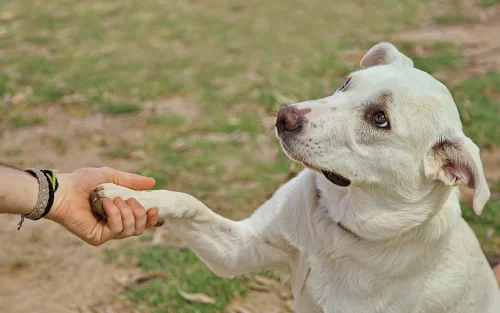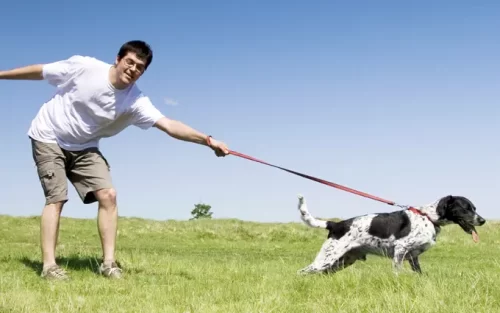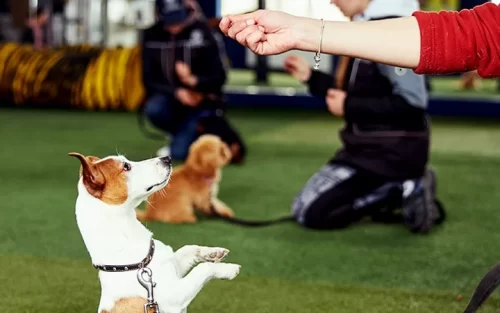Is your pooch prone to scurrying behind you when other dogs approach in the park? Does the sound of your doorbell ringing with guests induce a fearful bark from your furry friend? You’re navigating a tricky situation – although you want to ensure your dog’s comfort, you don’t want their nervous habits to obstruct their exposure to new human and canine companions. So, how do you introduce your dog to new people?
How to Familiarize Dogs with New Humans
Making a timid or anxious dog comfortable around new people should be gradual. Here are some suggestions for introducing dogs to new people in a non-threatening and relaxed way.
Keep Your Dog in a Separate Room Until All the Guests Are Comfortable
When you’re expecting company at your home, one of the best strategies to manage a nervous or shy dog is to keep them in a separate room initially. The presence of a new person in their territory can be overwhelming and unsettling for your pet. Therefore, giving your guest time to settle in and get comfortable is essential.
Allow them to remove their coat, sit down, and adjust to the new environment. During this time, your dog will also adjust to the fresh scent and sounds from a safe distance, which can help reduce their anxiety. Once your visitor is relaxed and seated, and the initial flurry of arrival activity has subsided, you can then gradually introduce your dog to the new person.
Allow Your Dog to Initiate the Interaction
It’s crucial to emphasize that your new visitor should only initiate contact with your dog once the animal has made it clear that they are ready for such interaction. This means that the guest should wait to approach the dog, attempt conversation, or try to pet them immediately. Dogs communicate their comfort level through body language. This can include wagging tails, relaxed postures, and approaches toward the visitor.
Until these signs are evident, it’s best to maintain a respectful distance to avoid potential stress or anxiety for the dog. By allowing your pet to set the pace for interaction, you’re ensuring their emotional well-being and fostering a positive first impression with the new person in their space.
Encourage the Newcomer to Present Treats to Your Dog
Without establishing eye contact with your dog, the new person should present dog treats or scatter them on the floor nearby. During this process, the new person should stand sideways or in a squatting position.
Avoid Rewarding Your Dog for Displaying Fear or Timidity
If you reward your dog for continuing to exhibit fear or timidity, you’re likely to postpone their progress and increase their chances of persisting with this undesirable behavior.
Patience is Vital
If your dog finds the offered treats appealing, they will eventually gather the courage to approach the new person, but it might take some time. Never hasten this process, as it could exacerbate your dog’s fear or anxiety.

How to Introduce Dogs to Other Dogs
Encouraging your dog to become at ease with other dogs can be achieved through positive encouragement, modifying their reactions, and interaction with a calm and friendly dog that they’re familiar with. Here are several strategies for initiating a meeting between your pet and a prospective dog companion.
Begin in a Tranquil, Neutral Setting
Ensure that you initiate this process in a controlled environment with minimal distractions or stimuli for your dog.
Introduce a Familiar, Well-Behaved Dog First
Introducing your pet to a confident, well-socialized dog can help you learn how to manage such introductions.
Take it Slow Initially
During this first introduction, ensure both dogs are securely leashed. Initially, maintain your distance from the other dog and their owner, rewarding your dog for displaying calm behavior. Then, approach the new dog slowly. You can let the dogs sniff and circle around each other when they eventually meet. Afterward, it would be best if you walked away with your dog.
Frequent Use of Positive Reinforcement
During the introductory phase, reward your dog every time they show signs of confidence, as this encourages a positive link with encountering unfamiliar dogs. Positive reinforcement is a simple yet effective way of letting your dog know it is doing OK, alongside the handy extra of strengthening your bond with your pooch.
Avoid Using Tight Leashes or Separating the Dogs Abruptly
Implementing a tight leash or forcefully pulling dogs apart can elicit an adverse reaction from your dog. Such actions can be perceived as threatening or restricting to your pet. They might interpret a tight leash as a sign of danger or stress, causing them to become anxious, fearful, or even aggressive. Similarly, forcibly separating dogs can be perceived as disrupting their natural social interactions, which can lead to confusion or stress.
It’s best to allow the dogs to naturally navigate their interactions under your watchful eye, stepping in only when necessary to ensure safety. This way, your pet can have a more positive and less stressful experience when interacting with other dogs.
Repeat the Procedure as Many Times as Needed
Depending on your dog’s level of shyness or fear, you may need to repeat this procedure several times for them to genuinely feel at ease around other dogs. Once they have built this confidence, you will feel more relaxed during your outings.
Why Some Dogs Struggle More with Meeting New Individuals and Pets
Identifying the root of why some dogs exhibit more fear around specific people or other dogs can be tricky. Still, positive socialization from an early age plays a critical role in cultivating confident and well-behaved pets. Puppies have a critical socialization window between 3 to 12 weeks of age.
During this essential period, you should introduce your puppy to a diverse range of people (including children, men, women, individuals in uniforms, men sporting beards and hats), other dogs (both friendly and of varying sizes), and different animals (like cats and small pets if available), and environments (such as grassy areas, concrete surfaces, and bodies of water). A positive experience in these interactions is crucial. Negative encounters during this stage might lead to a lifelong phobia that can be incredibly difficult to address.
By following these practical recommendations, you can help your dog overcome their anxieties and live a life filled with joy and confidence.



